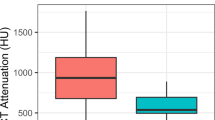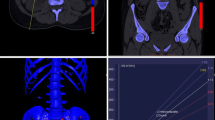Abstract
To investigate the optimal scanning parameters of dual-energy computed tomography (DECT), which can accurately determine sensitivity (the detectability of urinary stones) and accuracy (the composition matching of urinary stones), and to apply them to clinical trials. Fifteen urinary stones were chemically analyzed, and their chemical compositions were considered a reference standard with which we compared the uric acid (UA) and non-UA compositions determined using DECT. The urinary stones were placed inside a bolus and scanned with a dual-source CT scanner under various selected dual-energy conditions (A to X) using various solid water phantom thicknesses. These datasets were analyzed using the Siemens syngo.via software tool (integrated into the CT system) for matching the sensitivity and accuracy assessments. This study showed that 80% of the highest sensitivity (detection of urinary stones) and 92% of the highest accuracy (composition matching of urinary stones) were achieved under condition A (a collimation beam width setting of 2 × 32 × 0.6 mm, an automatic exposure control setting of 80/sn140 peak kilovoltage, and a slice thickness of 0.5/0.5 mm) (P < 0.05). Application of the DECT energy parameters presented in the study will help identify the sensitivity and accuracy of UA and non-UA stone analysis, even in patients with small-sized urinary stones and in conditions difficult for analysis.







Similar content being viewed by others
Data availability
We cannot open the clincal data for the ethical and legal problem. But we can open the partial data of urinary stones if you request.
References
McCollough CH, Leng S, Yu L, Fletcher JG (2015) Dual- and multi-energy CT: principles, technical approaches, and clinical applications. Radiology 276(3):637–653. https://doi.org/10.1148/radiol.2015142631
Eiber M, Holzapfel K, Frimberger M, Straub M, Schneider H, Rummeny EJ, Dobritz M, Huber A (2012) Targeted dual-energy single-source CT for characterisation of urinary calculi: experimental and clinical experience. Eur Radiol 22(1):251–258. https://doi.org/10.1007/s00330-011-2231-2
Li X, Zhao R, Liu B, Yu Y (2013) Gemstone spectral imaging dual-energy computed tomography: a novel technique to determine urinary stone composition. Urology 81(4):727–730. https://doi.org/10.1016/j.urology.2013.01.010
Primak AN, Fletcher JG, Vrtiska TJ, Dzyubak OP, Lieske JC, Jackson ME, Williams JC Jr, McCollough CH (2007) Noninvasive differentiation of uric acid versus non-uric acid kidney stones using dual-energy CT. Acad Radiol 14(12):1441–1447. https://doi.org/10.1016/j.acra.2007.09.016
Stolzmann P, Scheffel H, Rentsch K, Schertler T, Frauenfelder T, Leschka S, Sulser T, Marincek B, Alkadhi H (2008) Dual-energy computed tomography for the differentiation of uric acid stones: ex vivo performance evaluation. Urol Res 36(3–4):133–138. https://doi.org/10.1007/s00240-008-0140-x
Graser A, Johnson TR, Bader M, Staehler M, Haseke N, Nikolaou K, Reiser MF, Stief CG, Becker CR (2008) Dual energy CT characterization of urinary calculi: initial in vitro and clinical experience. Invest Radiol 43(2):112–119. https://doi.org/10.1097/RLI.0b013e318157a144
Boll DT, Patil NA, Paulson EK, Merkle EM, Simmons WN, Pierre SA, Preminger GM (2009) Renal stone assessment with dual-energy multidetector CT and advanced postprocessing techniques: imroved characterization of renal stone composition–pilot study. Radiology 250(3):813–820. https://doi.org/10.1148/radiol.2503080545
Eliahou R, Hidas G, Duvdevani M, Sosna J (2010) Determination of renal stone composition with dual-energy computed tomography: an emerging application. Semin Ultrasound CT MR 31(4):315–320. https://doi.org/10.1053/j.sult.2010.05.002
Kulkarni NM, Eisner BH, Pinho DF, Joshi MC, Kambadakone AR, Sahani DV (2013) Determination of renal stone composition in phantom and patients using single-source dual-energy computed tomography. J Comput Assist Tomogr 37(1):37–45. https://doi.org/10.1097/RCT.0b013e3182720f66
Evan AP, Willis LR, Lingeman JE, McAteer JA (1998) Renal trauma and the risk of long-term complications in shock wave lithotripsy. Nephron 78(1):1–8. https://doi.org/10.1159/000044874
Cappuccio FP, MacGregor GA (1993) The pathogenesis and treatment of kidney stones. N Engl J Med 328(6):444
Daudon M, Donsimoni R, Hennequin C, Fellahi S, Le Moel G, Paris M, Troupel S, Lacour B (1995) Sex- and age-related composition of 10 617 calculi analyzed by infrared spectroscopy. Urol Res 23(5):319–326. https://doi.org/10.1007/bf00300021
Kasidas GP, Samuell CT, Weir TB (2004) Renal stone analysis: why and how? Ann Clin Biochem 41(Pt 2):91–97. https://doi.org/10.1258/000456304322879962
Jura YH, Lahey S, Eisner BH, Dretler SP (2013) Ureteroscopic treatment of patients with small, painful, non-obstructing renal stones: the small stone syndrome. Clin Nephrol 79(1):45–49. https://doi.org/10.5414/cn107637
Apfaltrer G, Dutschke A, Baltzer PAT, Schestak C, Özsoy M, Seitz C, Veser J, Petter E, Helbich TH, Ringl H, Apfaltrer P (2020) Substantial radiation dose reduction with consistent image quality using a novel low-dose stone composition protocol. World J Urol 38(11):2971–2979. https://doi.org/10.1007/s00345-020-03082-6
Fung GS, Kawamoto S, Matlaga BR, Taguchi K, Zhou X, Fishman EK, Tsui BM (2012) Differentiation of kidney stones using dual-energy CT with and without a tin filter. AJR Am J Roentgenol 198(6):1380–1386. https://doi.org/10.2214/ajr.11.7217
Mostafavi MR, Ernst RD, Saltzman B (1998) Accurate determination of chemical composition of urinary calculi by spiral computerized tomography. J Urol 159(3):673–675
Bellin MF, Renard-Penna R, Conort P, Bissery A, Meric JB, Daudon M, Mallet A, Richard F, Grenier P (2004) Helical CT evaluation of the chemical composition of urinary tract calculi with a discriminant analysis of CT-attenuation values and density. Eur Radiol 14(11):2134–2140. https://doi.org/10.1007/s00330-004-2365-6
Sheir KZ, Mansour O, Madbouly K, Elsobky E, Abdel-Khalek M (2005) Determination of the chemical composition of urinary calculi by noncontrast spiral computerized tomography. Urol Res 33(2):99–104. https://doi.org/10.1007/s00240-004-0454-2
Haubenreisser H, Meyer M, Sudarski S, Allmendinger T, Schoenberg SO, Henzler T (2015) Unenhanced third-generation dual-source chest CT using a tin filter for spectral shaping at 100kVp. Eur J Radiol 84(8):1608–1613. https://doi.org/10.1016/j.ejrad.2015.04.018
Primak AN, Ramirez Giraldo JC, Liu X, Yu L, McCollough CH (2009) Improved dual-energy material discrimination for dual-source CT by means of additional spectral filtration. Med Phys 36(4):1359–1369. https://doi.org/10.1118/1.3083567
Acknowledgements
No funding was received to assist with the preparation of this manuscript.
Author information
Authors and Affiliations
Contributions
Conceptualization: J-JW, J-BS, HY, BIY; methodology: J-JW, J-BS, H-JC, SP; formal analysis and investigation: J-JW, J-B S, H-JC, SP; writing—original draft preparation: J-JW, J-BS; writing—review and editing: HY, BIY; resources: J-JW, J-BS; supervision: HY, BIY.
Corresponding author
Ethics declarations
Conflict of interest
The authors have no relevant financial or non-financial interests to disclose.
Additional information
Publisher's Note
Springer Nature remains neutral with regard to jurisdictional claims in published maps and institutional affiliations.
Rights and permissions
Springer Nature or its licensor (e.g. a society or other partner) holds exclusive rights to this article under a publishing agreement with the author(s) or other rightsholder(s); author self-archiving of the accepted manuscript version of this article is solely governed by the terms of such publishing agreement and applicable law.
About this article
Cite this article
Jung, JW., Shin, JB., Choi, HJ. et al. Optimal dual-energy computed tomography scan parameters to detect small-sized urinary stones and their composition. Urolithiasis 51, 54 (2023). https://doi.org/10.1007/s00240-023-01419-5
Received:
Accepted:
Published:
DOI: https://doi.org/10.1007/s00240-023-01419-5




